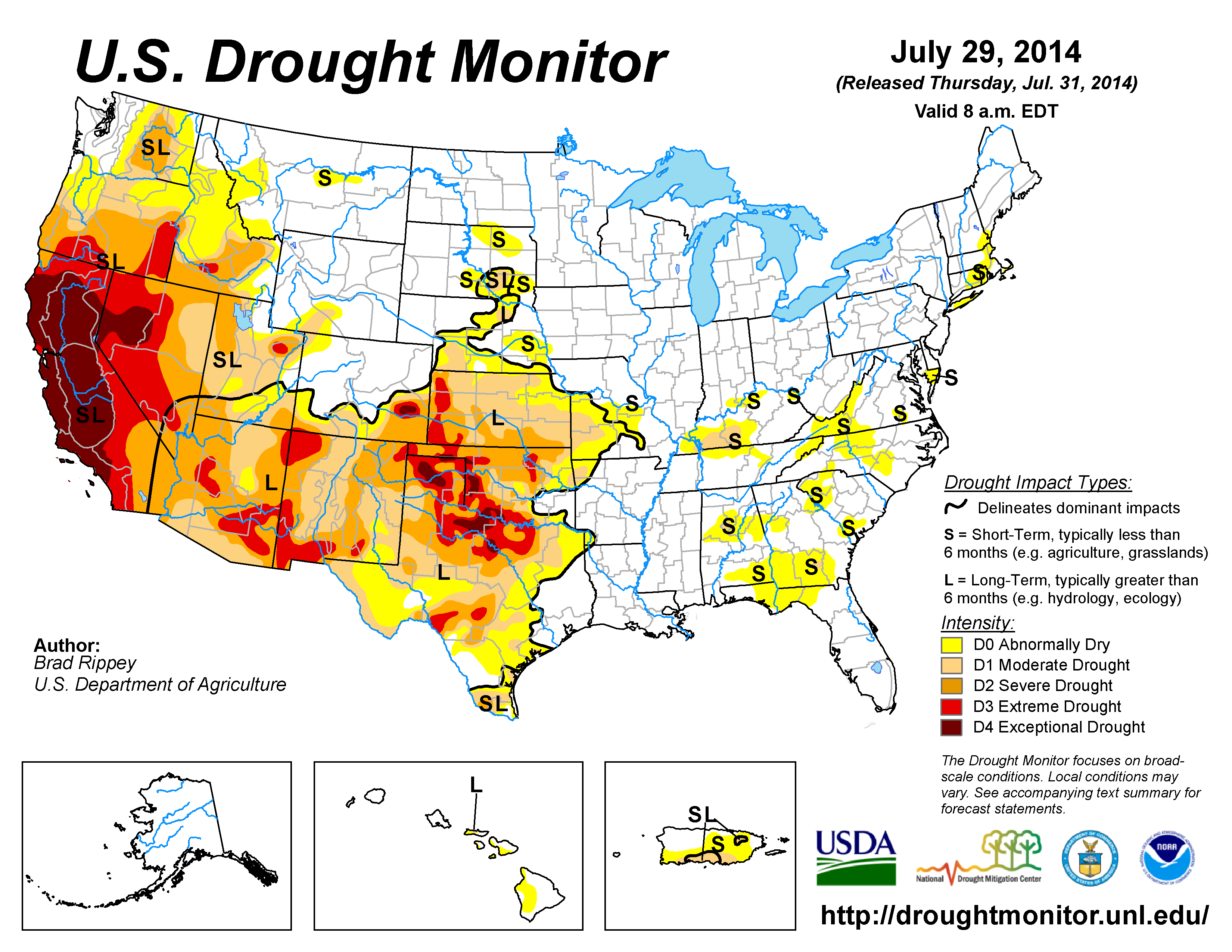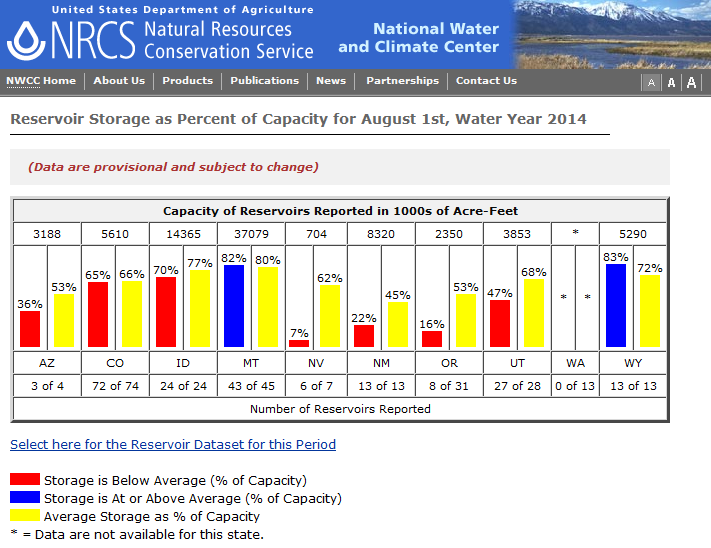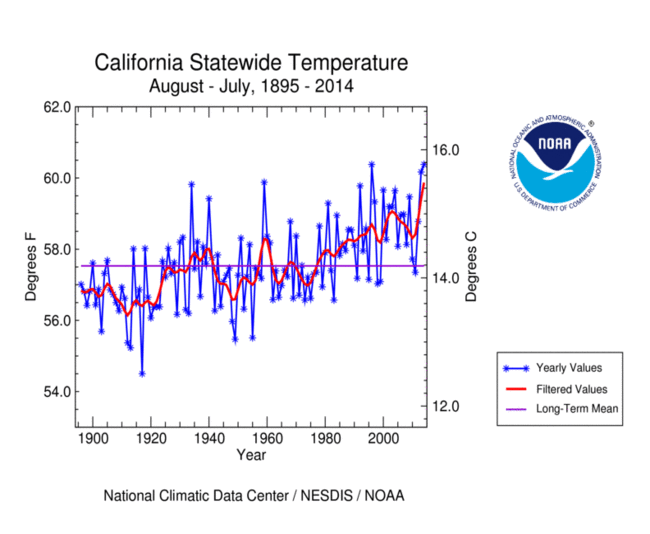|
Contents Of This Report: |
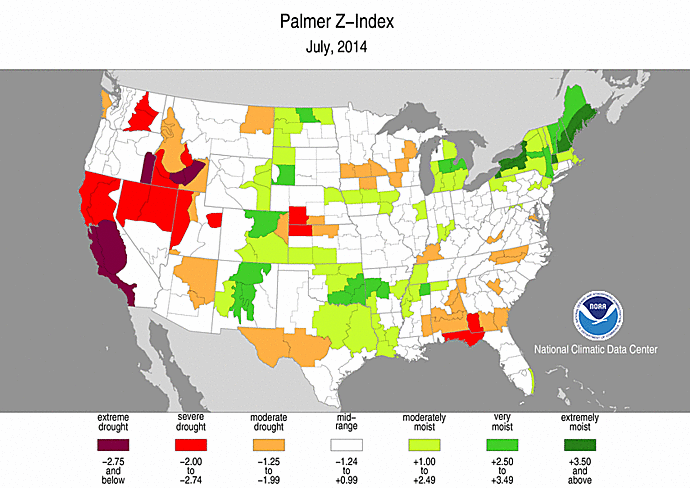
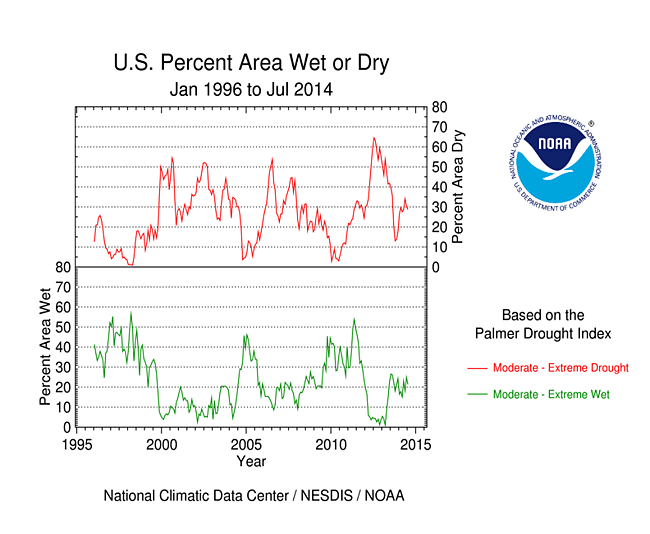
|
Please note that the values presented in this report are based on preliminary data. They will change when the final data are processed, but will not be replaced on these pages.
National Drought Overview
|
|
[top]
Detailed Drought Discussion
Overview
During July 2014, a high amplitude meridional (north-south) pattern dominated the upper-level circulation, with a strong upper-level long-wave trough over the eastern CONUS and an intense upper-level ridge over the West. Much-above-normal temperatures were associated with the western ridge, while much-below-normal temperatures were the rule in the central and eastern CONUS beneath the trough. This circulation pattern produced a northwesterly flow over the central CONUS which inhibited precipitation across the Northern Rockies, Northern to Central Plains, and parts of the West, Midwest, and Southeast. Monsoon showers brought above-normal precipitation to the Southwest, while frontal showers gave parts of the Southern Plains above-normal precipitation. The month was wetter than normal along the East Coast, especially the Northeast, due to frontal rains and Hurricane Arthur. The above-normal rainfall helped reduce the area of drought in the Southern Plains and reduce drought intensity in the Southwest. But drought expanded or intensified in other parts of the West and Plains, and drought and abnormal dryness expanded in the Southeast and in Puerto Rico. Alaska was generally cooler than normal with a mixed precipitation pattern, but wet conditions were more evident. The month was generally wetter than normal across Hawaii. When integrated across the CONUS, July 2014 ranked as the 26th driest July in the 1895-2014 record. On balance, the national drought footprint changed very little when compared to last month, increasing slightly to about 28.5 percent of the U.S. as a whole, according to USDM statistics. According to the Palmer Drought Index, which goes back to the beginning of the 20th century, about 29 percent of the CONUS was in moderate to extreme drought at the end of July, a decrease of about 1 percent compared to last month.
By the end of the month:
- moderate (D1) to severe (D2) drought covered a large area of the U.S. continuously from the West Coast to the Great Plains, connected across parts of New Mexico;
- there were two epicenters of extreme (D3) to exceptional (D4) drought within this large drought area — one located in the California-Nevada region and the other in the Southern Plains centered in northern Texas and extending outward into New Mexico, Oklahoma, southeast Colorado, and western Kansas;
- pockets of moderate drought (D1) and abnormally dry conditions (D0) were growing in the Southeast to Ohio Valley;
- moderate drought (D1) and abnormally dry conditions (D0) expanded in Puerto Rico; and
- patches of moderate drought and abnormal dryness lingered in Hawaii.
Palmer Drought Index
The Palmer drought indices measure the balance between moisture demand (evapotranspiration driven by temperature) and moisture supply (precipitation). The Palmer Z Index depicts moisture conditions for the current month, while the Palmer Hydrological Drought Index (PHDI) and Palmer Drought Severity Index (PDSI) depict the current month's cumulative moisture conditions integrated over the last several months. While both the PDSI and PHDI indices show long-term moisture conditions, the PDSI depicts meteorological drought while the PHDI depicts hydrological drought. The PDSI map shows less severe and extensive drought in the West and parts of the Plains than the PHDI map because the meteorological conditions that produce drought are not as long-lasting as the hydrological impacts.
 |
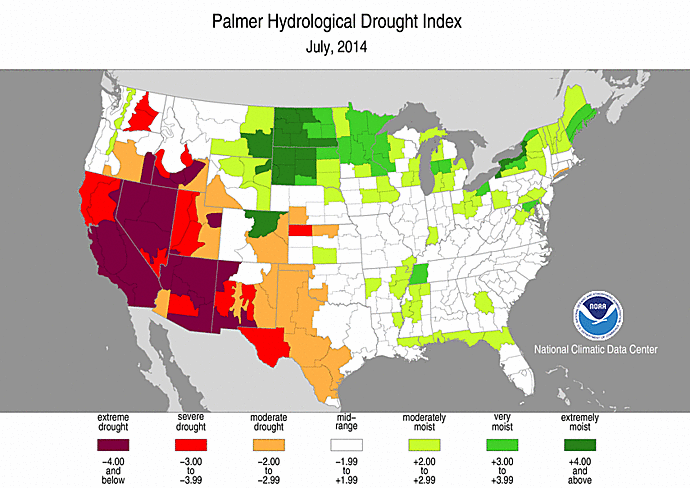 |
Used together, the Palmer Z Index and PHDI maps show that short-term wet or normal conditions occurred during July over most of the Southern Plains and Southwest which had areas in long-term drought during June, resulting in contraction of drought by the end of July. Short-term dry conditions occurred over much of the West, which had areas in long-term drought during June, resulting in an intensification of drought by the end of July. Short-term dry conditions also occurred over parts of the Central Plains, expanding long-term drought conditions, and over parts of the Southeast and Upper Midwest, contracting the long-term wet areas. Wet short-term conditions occurred over parts of the long-term near normal to wet areas of the Northeast and Great Lakes, resulting in expansion of the wet spell areas there.
Standardized Precipitation Index
The Standardized Precipitation Index (SPI) measures moisture supply. The SPI maps here show the spatial extent of anomalously wet and dry areas at time scales ranging from 1 month to 24 months.
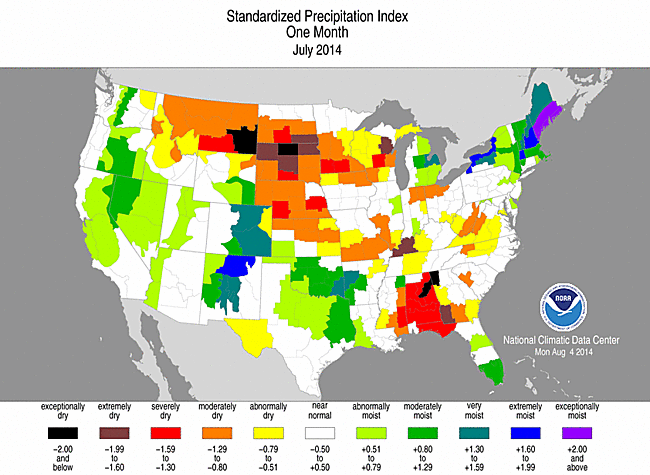 |
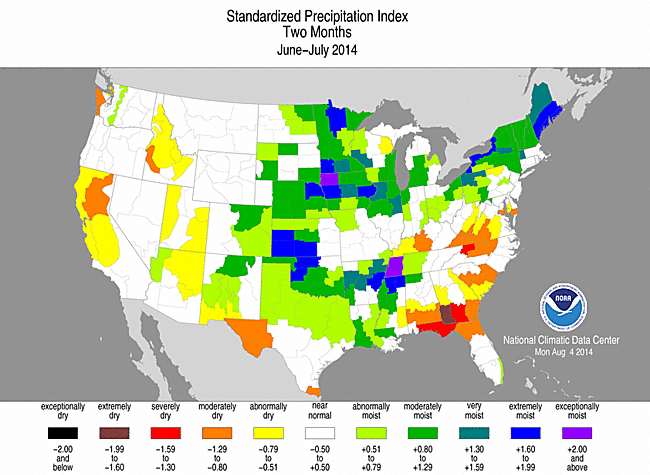 |
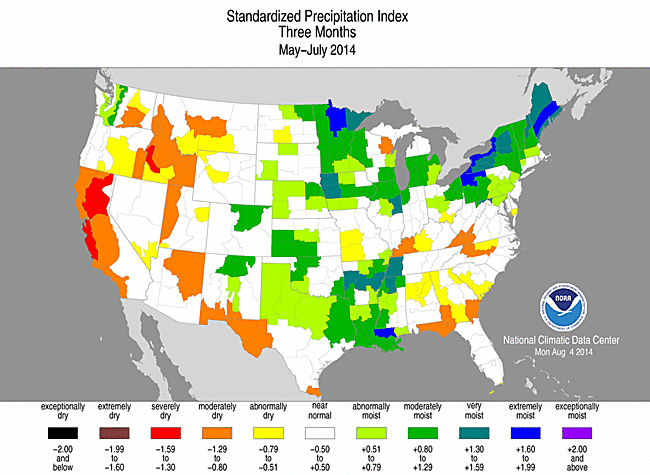 |
The SPI maps illustrate how moisture conditions have varied considerably through time and space over the last two years. Monsoon showers brought above-normal precipitation to parts of the West during July, but it was not enough to erase long-term deficits, even at the 2-month time scale, except for New Mexico. Parts of New Mexico register as wet out to 3 months. The dryness in California is most evident at 3 months and especially at 9 to 24 months. The Pacific Northwest alternates between dry and wet and near normal at various time scales. Beneficial precipitation in recent months painted much of the Southern Plains wet at the 1- to 3-month time scales, but dryness is evident beginning at 6 months. Parts of the Southeast show up as dry at 1 to 6 months, with near normal conditions for much of the region at 9 to 12 months and wet conditions at 24 months. The eastern Great Lakes to Northeast are generally wetter than normal at all time scales, except dryness shows up in southern New England at 12 to 24 months. July was dry across much of the Midwest, but the region is wet at the other time scales. The Northern to Central Plains were also dry in July. The Northern Plains are wet to near normal at longer time scales, while the Central Plains are wet to near normal from 2 to 3 months with dryness creeping back in at longer time scales. The last 1 to 3 months, and 9 to 24 months, show up as dry in the Northern Rockies, but the 6-month time scale is wet.
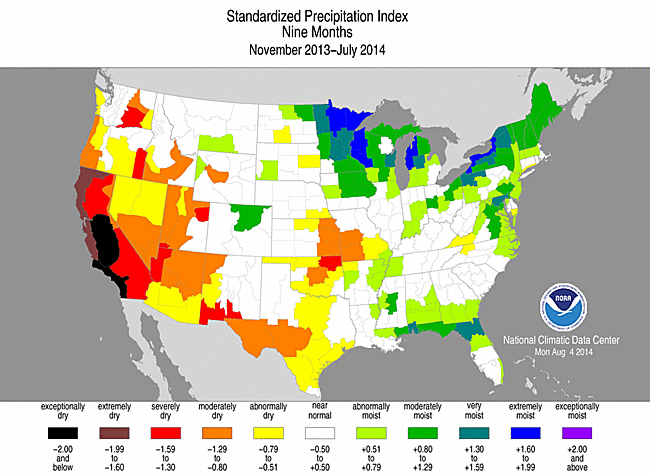 |
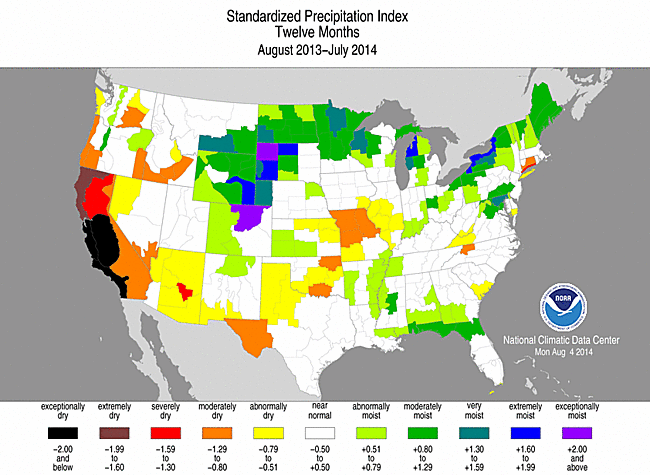 |
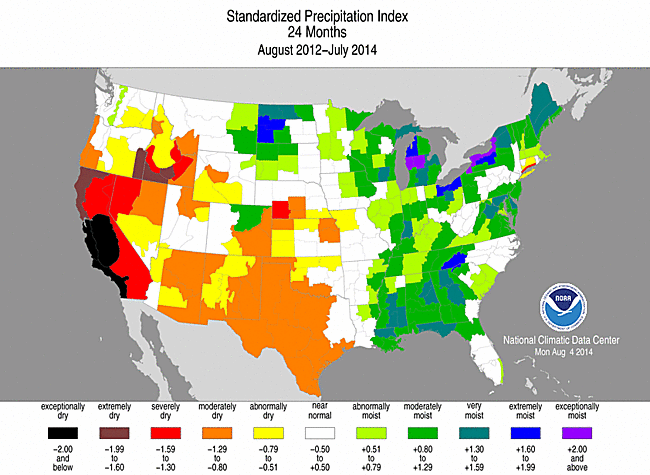 |
Agricultural, Hydrological, and Meteorological Indices and Impacts
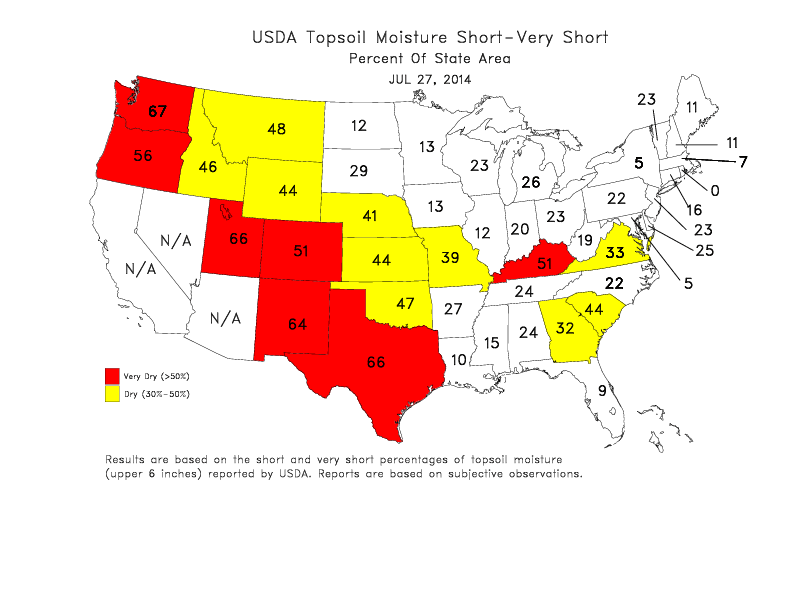 |
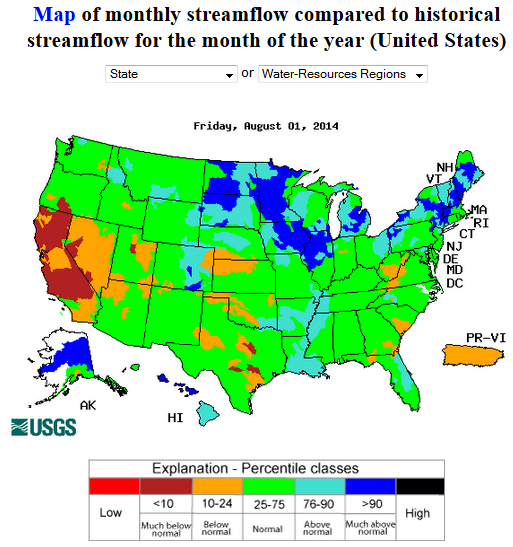 |
Drought conditions were reflected in numerous agricultural, hydrological, and other meteorological indicators, both observed and modeled.
While above-normal July rains in the Southwest and Southern Plains brought drought relief and contracted drought areas and intensities locally, well-above-normal temperatures increased evaporative stress (especially in the West), so little improvement was seen in many agricultural indicators from the end of June to the end of July. Modeled and observed topsoil moisture improved locally where it rained and topsoils dried out where it didn't (especially in the Northern and Central Plains), but on a statewide basis, topsoil moisture conditions deterioriated across most of the West and Plains compared to four weeks ago. According to July 28th statistics from the U.S. Department of Agriculture (USDA), more than 50 percent of the topsoil was rated short or very short of moisture (dry or very dry) in California (80%), Washington (67%), Texas (66%), Utah (66%), New Mexico (64%), Oregon (56%), and Colorado (51%), with dry conditions developing in the Ohio Valley (Kentucky had 51 percent topsoil dry or very dry). Subsoil moisture continued dry to very dry across these states, with more than 50 percent of the subsoil moisture rated short or very short in California (85%), Nevada (70%), Utah (68%), New Mexico (67%), Texas (65%), Oklahoma (65%), Washington (65%), and Oregon (58%).
Vegetation continued to be stressed, with USGS models indicating the potential for wilting or crop failure across much of the Southern Plains to West. As of July 29th, about 25 percent of hay, 8 percent of corn, and 5 percent of soybeans were in drought (about the same as four weeks ago), 35 percent of the cattle inventory was in drought (down 1 percent), and 47 percent of winter wheat was in drought (up 1 percent). July 28th USDA reports indicated that five percent of the nation's spring wheat crop was rated in poor to very poor condition, about the same as a month ago, with 33 percent so rated in Washington state. Six percent of the soybean crop and six percent of the corn crop were rated in poor to very poor condition. Nationally, 17 percent of the pasture and rangeland was in poor to very poor condition, with statewide values over 50 percent in California (70%), New Mexico (65%), and Arizona (56%), and approaching 50 percent in South Carolina (45%). The hot temperatures, low humidities, and prolonged dryness contributed to the development of large wildfires in many parts of the West.
The subnormal precipitation in the Far West was reflected in below-normal monthly precipitation totals as well as lack of rain days and long runs of consecutive dry days. These indicators also showed dryness in parts of the Central Plains and adjoining Midwest.
Streamflow and modeled runoff averaged below normal across much of the West and parts of the Plains and Southeast, with some basins averaging much below normal and some stream gauges measuring record low monthly values for July.
The monsoon precipitation in the Southwest during a
Regional Discussion
Hawaii: July 2014 was wetter than normal across most of Hawaii. Only a few stations are drier than normal in the near-term (last 2, 3, and 4 months), and most stations were wetter than normal at 6 months. Long-term dry conditions were evident at a few stations at the 7, 10, and 12 month time scales, and were widespread at 24, and 36 months. On the USDM map, moderate drought covered less than one percent of the state this month, but the area in abnormally dry to moderate drought conditions expanded to 28 percent this month compared to 19 percent last month.
Alaska: The precipitation pattern for July was mixed across Alaska, with the dry conditions mainly concentrated at the southeast interior stations. Near normal to wet conditions dominated at the 2-month time scale and for the water-year-to-date at the high elevation (SNOTEL) basin scale, but precipitation was below normal for some southern and interior southeast stations at other time scales (last 3, 4, 6, 7, 10, 12, 24, and 36 months). The July 29th USDM map was free of drought and abnormal dryness.
Puerto Rico: July 2014 continued a dry pattern for much of Puerto Rico, with just parts of the northwest wetter than normal. This pattern of precipitation anomalies is evident at longer time scales (last 2, 3, 6, 7, and 10 months), with the greatest dryness (lowest percent of normal and biggest deficits) located in the central to south coastal regions. Rainfall deficits in excess of four inches were indicated in the eastern areas for July, in excess of eight inches in the eastern and southern areas for the last 3 months, and in excess of 20 inches for the last 10 months. July streamflows were below to much below normal at several stations, there were reports of stressed vegetation and wildfires, and water rationing plans were being implemented. Moderate drought was introduced, with abnormally dry to moderate drought conditions expanding to cover about 59 percent of the island on the USDM map, compared to about 40 percent abnormally dry last month. Beneficial rains from a tropical system brought partial relief from the drought in early August.
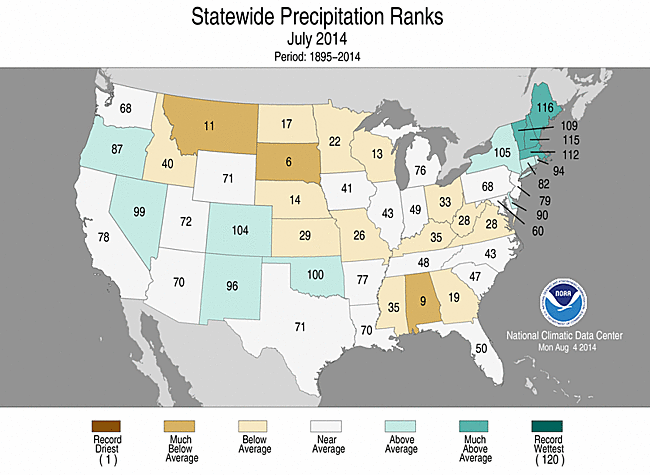 |
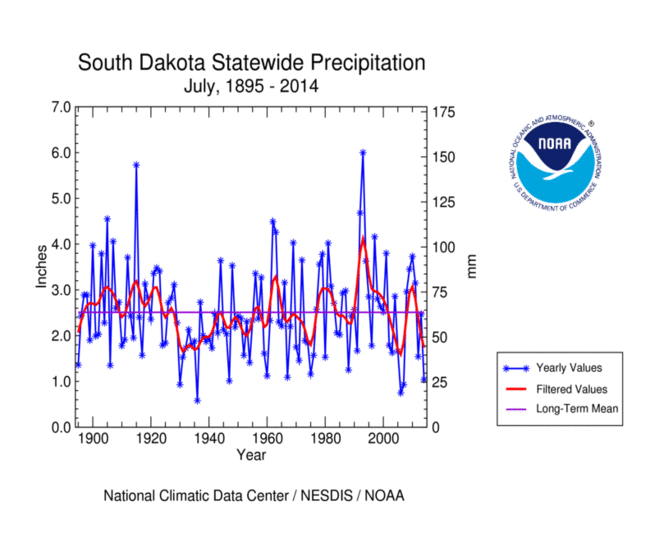
|
The July precipitation anomaly pattern of dryness in the Far West, Northern Rockies to Northern and Central Plains, and portions of the Midwest to Southeast was reflected in the state ranks. South Dakota had the sixth driest July in the 1895-2014 record and Alabama the ninth driest. Fourteen other states had July precipitation ranks in the dry third of the historical record.
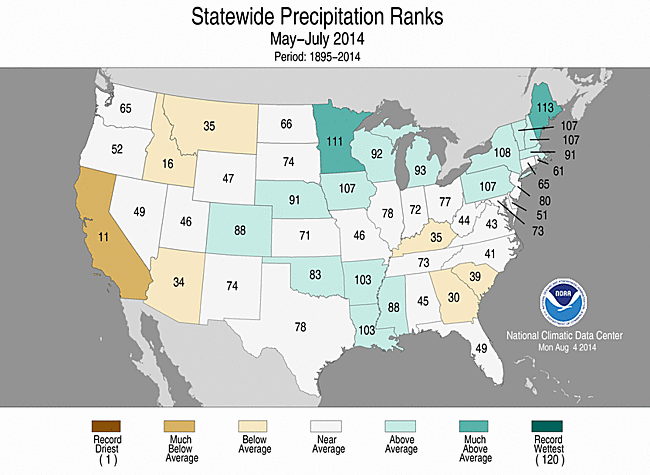 |
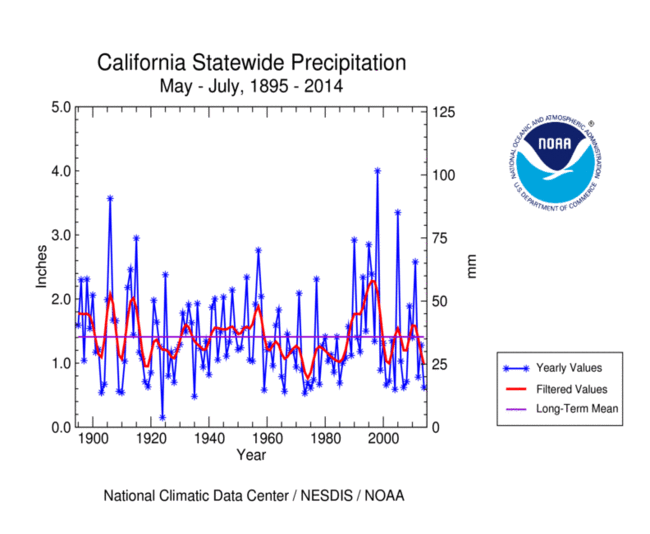
|
At the three-month time scale, persistent dryness across much of the West gave California their eleventh driest May-July, with 2014 marking the third consecutive year with a drier-than-average May-July period. Six other states had a precipitation rank in the driest third of the historical record, but localized pockets of above-normal precipitation prevented many others from qualifying.
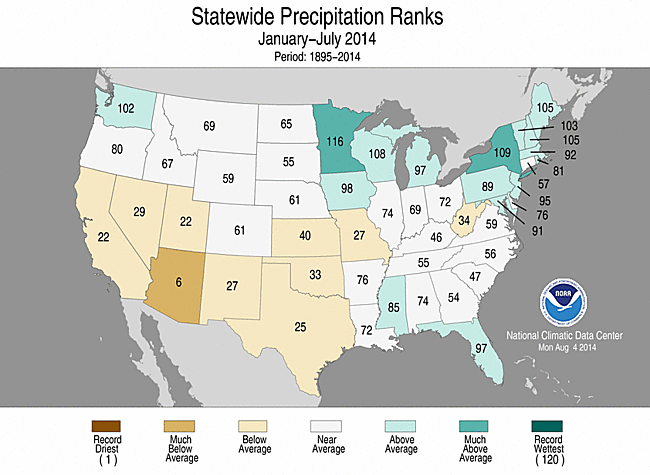 |
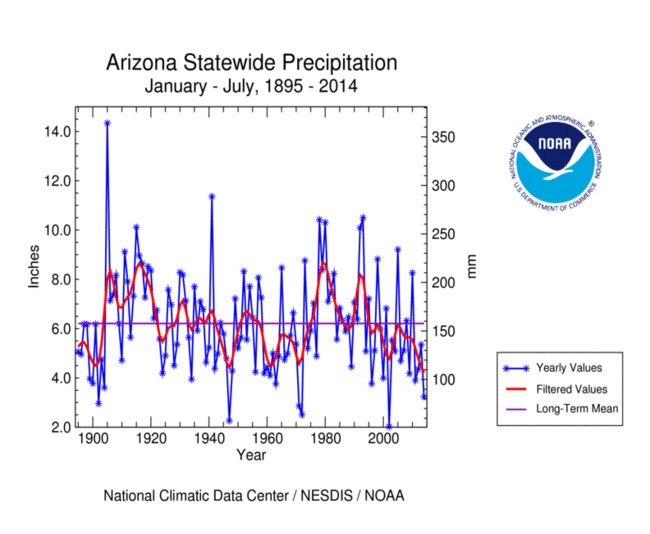
|
The January-July 2014 precipitation anomaly pattern of dryness in the Southwest, Southern to Central Plains, and adjacent Midwest was reflected in the state ranks. Ten states ranked in the driest third of the historical record, with Arizona having its sixth driest year-to-date. The precipitation anomaly pattern for the last six months (February-July 2014) was similar although not as extreme, with five states ranking in the driest third of the historical record.
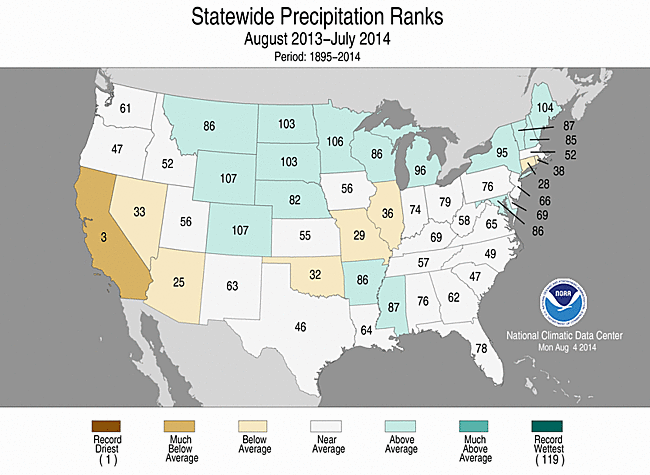
|
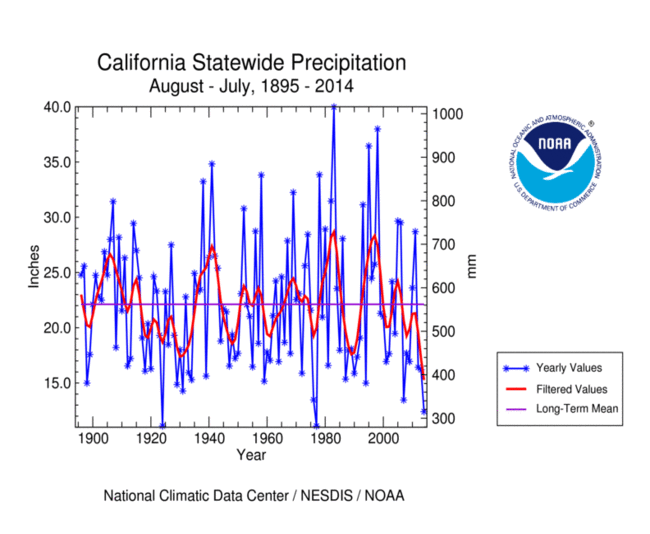
|
For the last twelve months (August 2013-July 2014), dryness dominated much of the West, the Southern Plains to Midwest, and Southern New England, with pockets of wetness in most of the dry areas. California was especially hard hit, having the hottest and third driest August-July on record. Only 1923-24 (second driest) and 1976-77 (driest) had a drier August-July in California. Seven other states ranked in the driest third of the historical record for August-July.
Standardized Precipitation Evapotranspiration Index:
The SPI measures water supply (precipitation), while the SPEI (Standardized Precipitation Evapotranspiration Index) measures the combination of water supply (precipitation) and water demand (evapotranspiration as computed from temperature). Warmer temperatures tend to increase evapotranspiration, which generally makes droughts more intense.
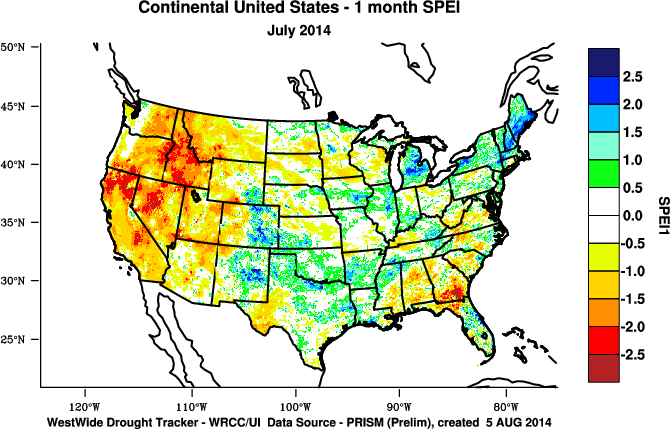 |
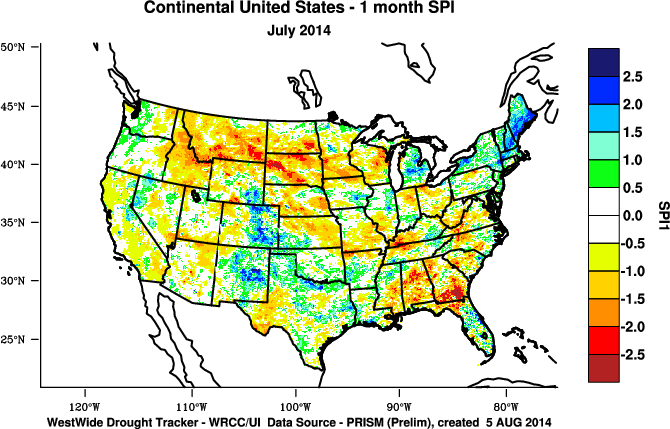 |
An intense long-wave ridge in the upper atmosphere was entrenched over the West during July. Unusually warm temperatures were associated with the ridge, with six states having their tenth warmest, or warmer, July in the 1895-2014 record. The unusual warmth exacerbated the drought conditions in the West as seen by more severe SPEI drought values when compared to the SPI values. Conversely, the unusually colder-than-normal temperatures underneath an upper-level long-wave trough east of the Rockies reduced the severity of drought in the Midwest as seen by less severe SPEI values when compared to SPI values.
The upper-level circulation pattern of ridge west/trough east has persisted throughout much of the last year, and beyond. As a result, the pattern of unusual warmth in the West and colder-than-normal temperatures east of the Rockies has also persisted, with its attendant effects on drought intensity. At every time scale, the unusual warmth (and record heat at longer time scales) has exacerbated drought in the West as seen when the SPEI is compared to the SPI (3-month SPEI vs. SPI; 6-month SPEI vs. SPI; 7-month SPEI vs. SPI; 12-month SPEI vs. SPI; 24-month SPEI vs. SPI; 36-month SPEI vs. SPI; 48-month SPEI vs. SPI). When integrated across California, the SPEI for August 2013-July 2014 is the most extreme such 12-month SPEI in the 1895-2014 record. The corresponding 12-month SPI for California is the second most extreme on record. At longer time scales, however, both the California SPEI and SPI are the most extreme on record, but the SPEI is more extreme than the SPI (18-month SPEI and SPI, 36-month SPEI and SPI).
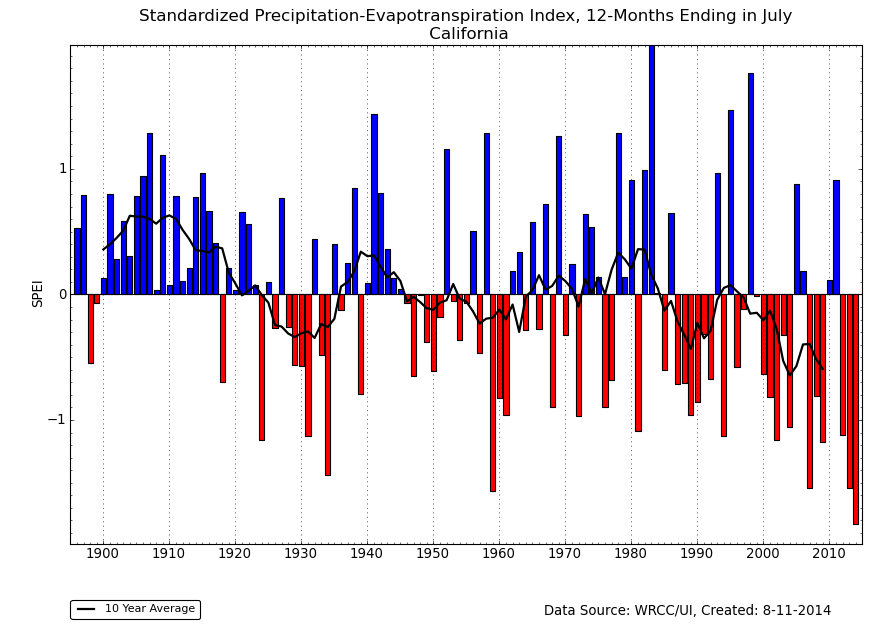 |
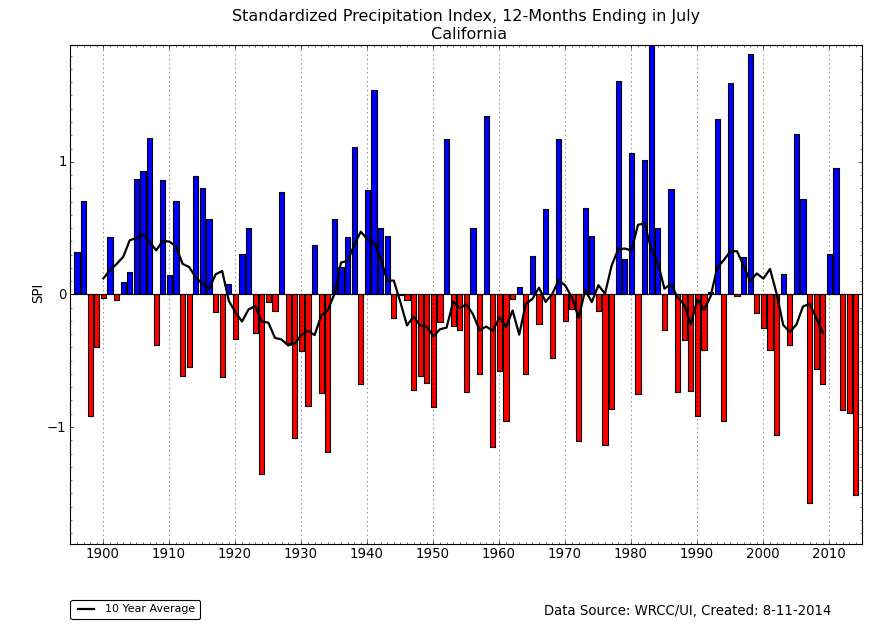 |
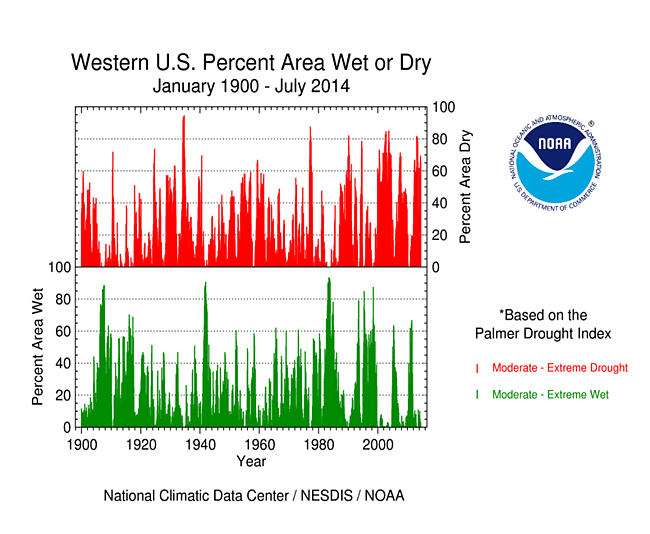 Percent area of the Western U.S. in moderate to extreme drought, January 1900 to present, based on the Palmer Drought Index. As noted above, dry weather has dominated the West for the last several months, resulting in significant hydrological (low lake, reservoir, and stream levels) and agricultural impacts. According to the USDM, 60.9 percent of the West was experiencing moderate to exceptional drought at the end of July, which is about the same as the previous month. But continued hot and dry conditions increased the intensity of the drought in some areas, especially California, with 58.4 percent of the state experiencing the worst drought category (exceptional drought) at the end of July compared to 36.5 percent at the beginning of the month. The Palmer Drought Index percent area statistic for the West was 65.2 percent, a decrease of about 4 percentage points from the previous month. |

|
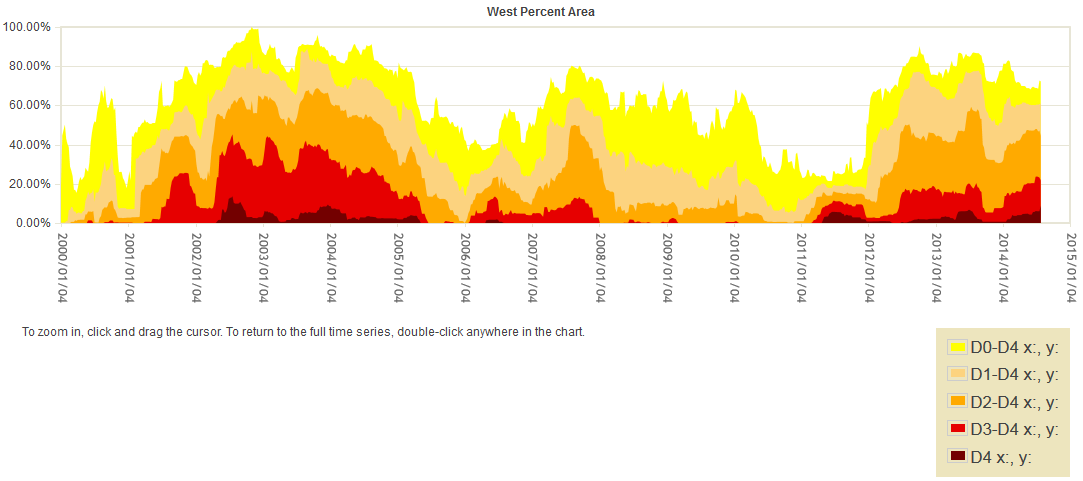
|
The Climate Extremes Index (CEI) aggregates temperature and precipitation extremes across space and time. The PDSI (drought) component of the CEI for the West region (California and Nevada) for 2014 was the most extreme value in the 1910-2014 record for July and the year to date (January-July). The West region also had the second most extreme warm minimum temperature component and eighth most extreme warm maximum temperature component for July, and the most extreme warm maximum temperature component, second most extreme warm minimum temperature component, and 15th most extreme days without precipitation component for the year to date. This combination of extreme warmth and dryness gave the West region their most extreme CEI on record for January-July and second most extreme CEI for July.
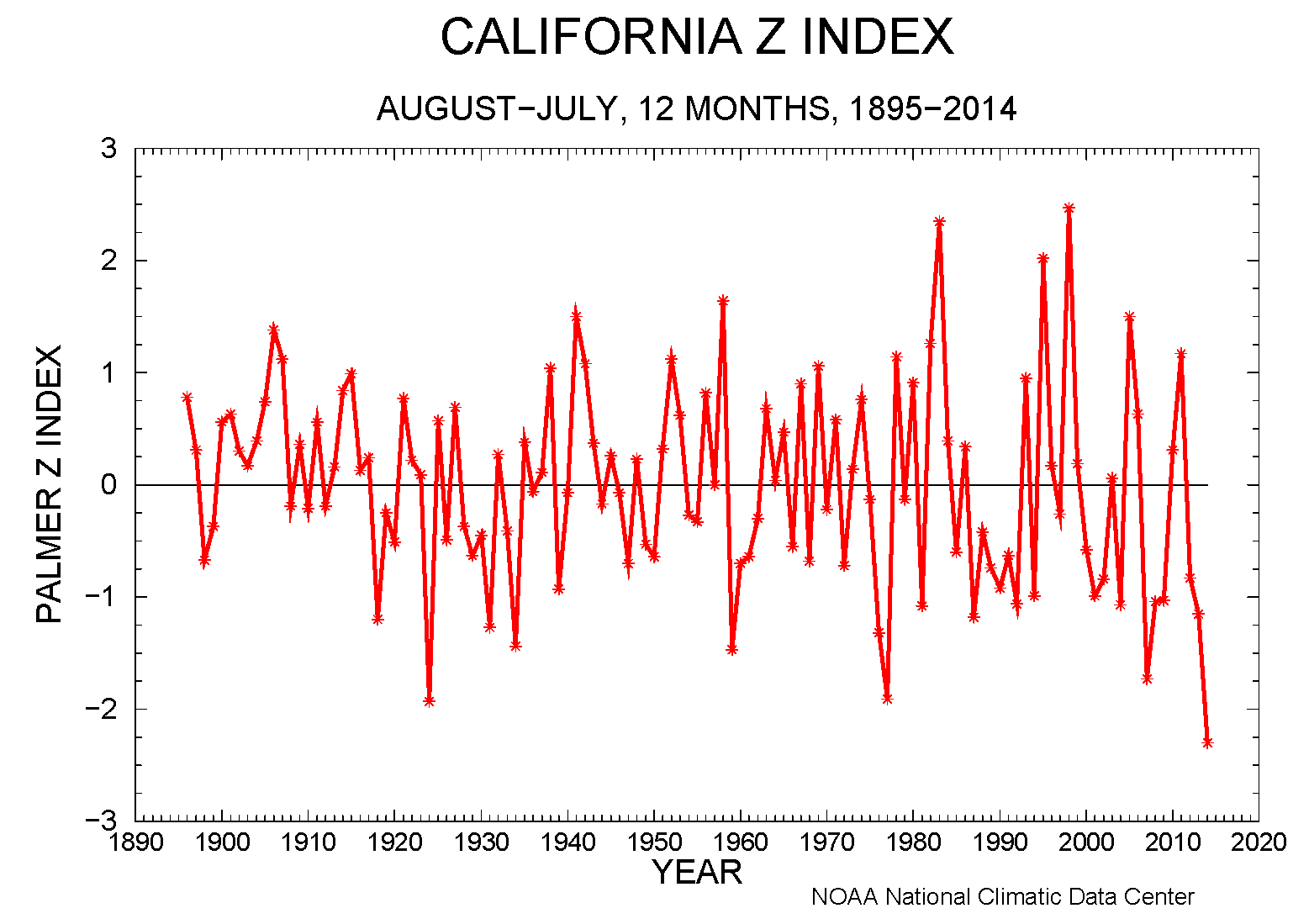
|
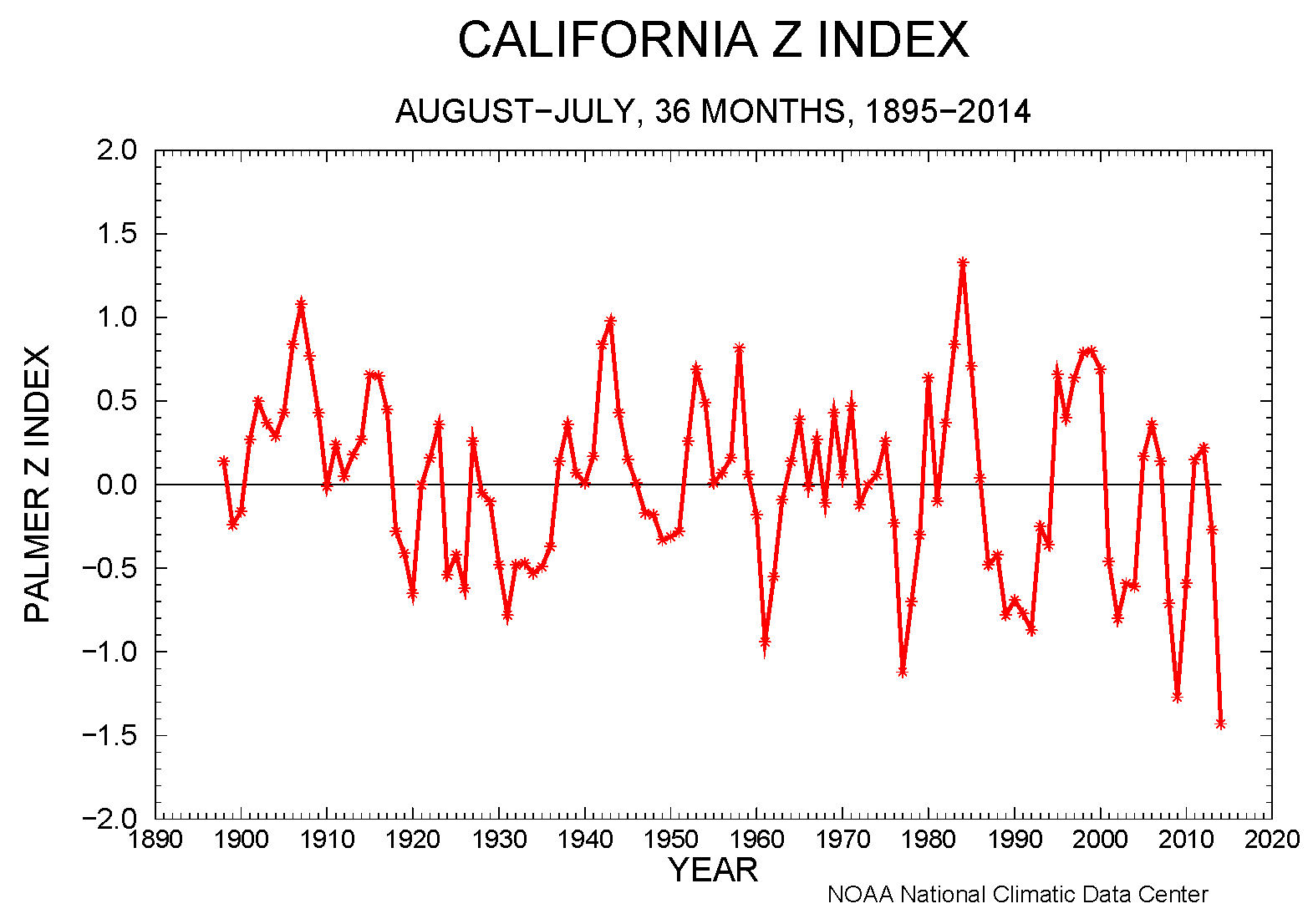
|
As noted in earlier sections, above-normal temperatures can exacerbate drought conditions. Like the SPEI, the Palmer Z Index incorporates temperature (water demand) and precipitation (water supply). The statewide Palmer Z Index for California, averaged over several time periods, illustrates the severity of the impact of hot temperatures with low precipitation. The California Palmer Z Index averaged over the 12-month period, August-July, indicates that 2013-14 has had the most severe drought conditions in the 1895-2014 record, followed by 1976-77 and 1923-24, which were virtually tied for second place. The Palmer Z Index averaged over the last 18 months, 24 months, and 36 months was also the lowest on record for the periods ending in 2014. At the 48 month and 60 month time scales, 2014 was not a record.
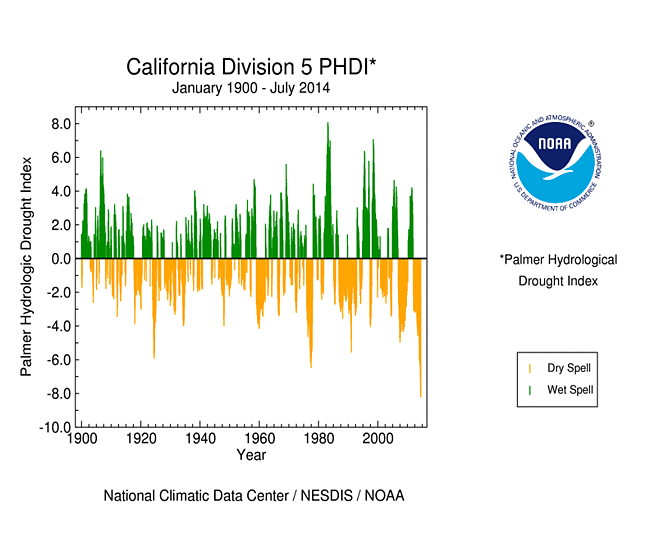
|
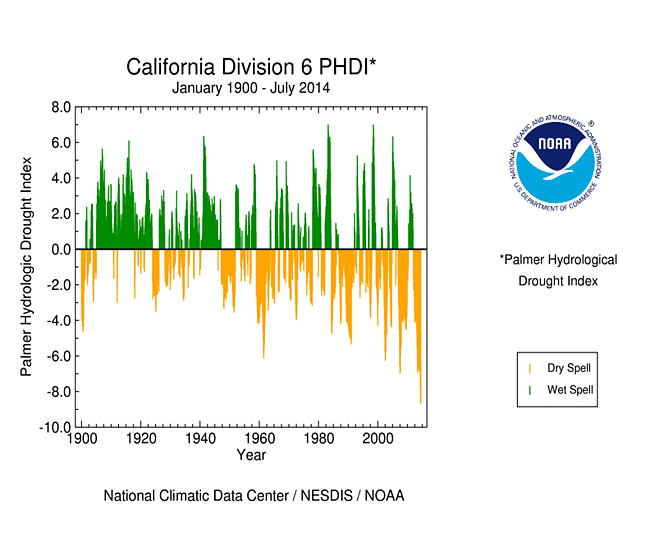
|
The long-term dryness in California is reflected in PHDI values which continue to fall. The July 2014 PHDI has far surpassed previous record low values for the Central Coast Drainage (climate division 4), the San Joaquin Drainage (climate division 5), and the South Coast Drainage (climate division 6), as well as statewide. Some of these analyses show a disturbing trend toward more extreme droughts over the last 40 years in California.
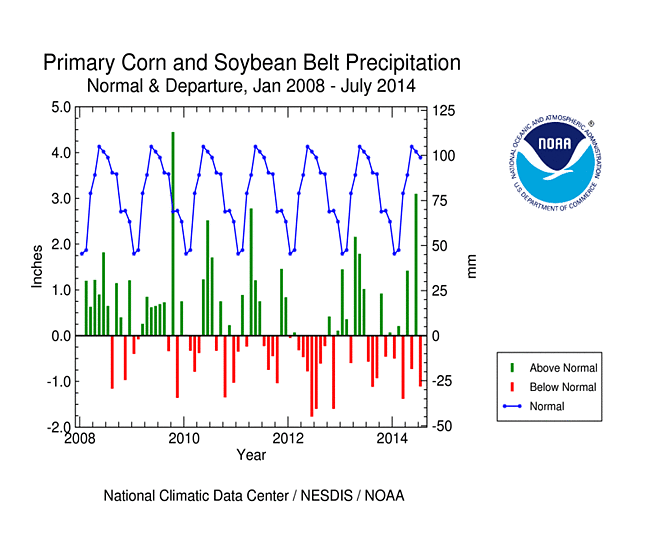
|
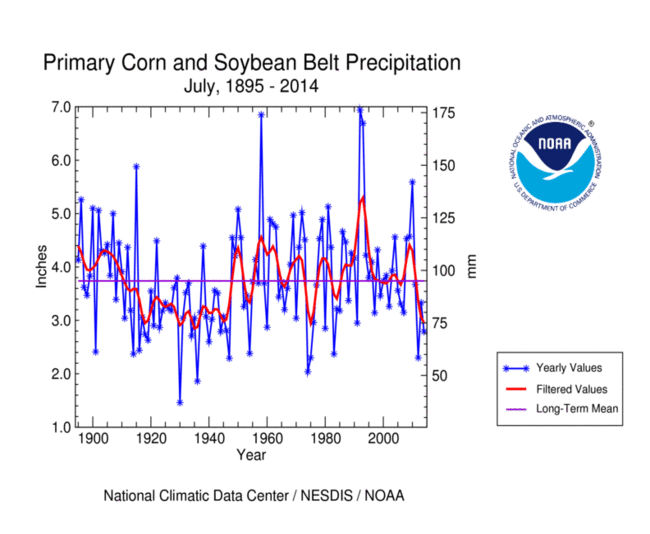 |
The growing season for the Primary Corn and Soybean agricultural belt has alternated between wetter-than-normal and drier-than-normal months. July 2014 was drier than normal, ranking as the 16th driest July, but the month was also the second coldest July on record, so the impact of the dryness on agriculture was minimized. The growing season to date (March-July 2014) ranked as the 36th wettest and 22nd coldest March-July.
NOAA Regional Climate Centers:
A more detailed drought discussion, provided by the NOAA Regional Climate Centers and others, can be found below.
West — Pacific Islands
As described by the High Plains Regional Climate Center, the country was divided this month with above normal temperatures dominating the western CONUS and below normal temperatures in the central and eastern CONUS. This left the High Plains region split as well, with cooler conditions for the Dakotas, Nebraska, and Kansas and warmer conditions in western portions of Colorado and Wyoming. The region was generally dry this month, with the main exceptions in central Colorado, southeastern Wyoming, and south-central Kansas. Precipitation totals were quite low across much of Kansas, Nebraska, South Dakota, and North Dakota with widespread precipitation totals of less than 50 percent of normal. Embedded within this area were some locations that received less than 25 percent of normal precipitation. Some locations in the eastern part of the region shifted from extreme wetness to extreme dryness. North Platte, Nebraska went from its 2nd wettest June with 8.75 inches (222 mm) to its driest July on record with 0.14 inch (4 mm). This beat the old record of 0.34 inch (9 mm) set all the way back in 1901 (period of record 1874-2014). A couple of other dry locations included Lincoln, Nebraska with its 7th driest July and Aberdeen, South Dakota with its 5th driest.
Overall, there was little change to the drought conditions in the High Plains region this month. According to the USDM, approximately 22 percent of the region remained in moderate (D1) to exceptional (D4) drought at the end of July. This range of conditions at the end of June totaled 23 percent. While June was very wet across the eastern half of the region, July was quite dry. Some areas of eastern South Dakota and Nebraska received little precipitation in July and so abnormally dry conditions (D0) reemerged. An area of D1 also developed in southeastern South Dakota as well as southwestern Wyoming and northwestern Colorado. Kansas had significant improvements regarding extreme drought (D3), decreasing from 21 percent to 9 percent coverage. Conditions in Colorado improved in the east and degraded slightly in the west. Colorado continued to have the last remaining D4 area in the region.
Crop impacts varied greatly this month. Warm and wet conditions aided pasturelands in southeastern Wyoming, while cooler conditions slowed row crop development in North Dakota. Some crop damage occurred due to severe storms, but not nearly as badly as the past two of months. Meanwhile, the residual moisture from June was beneficial to areas which turned extremely dry in July. For example, irrigation in Nebraska started later than usual.
As explained by the Southern Regional Climate Center, July was cooler than normal and precipitation varied spatially over the region. The state of Oklahoma, along with northern Texas, enjoyed a wetter than normal month, which helped alleviate drought conditions; however, other portions of the region saw precipitation totals that were only 50 to 70 percent of normal. Drier than normal areas included southern Texas, northern Arkansas, southern Mississippi, and much of central and western Tennessee.
Drought conditions in the Southern region improved over much of Oklahoma and Texas, with some areas seeing a one category improvement. Rainfall in eastern Tennessee resulted in the removal of drought conditions there, however, some counties in the northeast are still abnormally dry. In total, the region improved by approximately three percent in areal coverage in terms of moderate drought conditions or worse. There was also a four percent reduction in the amount of extreme and exceptional drought in Texas and Oklahoma combined. These improvements were the direct consequence of above normal precipitation for the month of July. In Texas, agricultural conditions were complicated by the lack of rain in many parts of the state. The USDA reports as much as 64% of the state's planting regions are either short or very short on topsoil and subsurface soil moisture. Development and harvests of corn, sorghum, sunflowers, rice, and cotton are all behind their averages as well as behind 2013 levels, though separate reports show that the crops themselves are in good conditions for now, with 6% of corn, 22% of cotton, and 12% of sorghum rated as poor or very poor; cotton has been getting worse in the last few weeks of July, however. On the other hand, there is good news for other regions of the state, with South Texas producing one of the first soybean harvests in the entire country, due to an adapted species of the plant, with 60 bushels per acre priced at $14 per bushel (Information provided by the Texas Office of State Climatology).
As summarized by the Midwest Regional Climate Center, July temperatures were below normal across the region and July precipitation was drier than normal for much of the Midwest. For the nine-state region, it was the second coolest July (1895-2014 period of record) trailing only 2009. Rainfall totals were generally lower than normal with some pockets of above normal rainfall from eastern Iowa to western Kentucky and also along the northern edge of the region near the Great Lakes. Lower Michigan was the only area with much above normal rainfall of 150 to 200 percent of normal for the month. On the other end of the spectrum, areas receiving less than 50 percent of normal were scattered across seven states, sparing only Michigan and Ohio. Michigan's statewide precipitation was above normal while the other eight states fell below normal, in roughly the 10th to 40th percentile.
Drought area increased slightly during July but remained limited to moderate drought, the lowest category. An area of southwest Missouri was impacted by drought at the beginning of July and the parts of western Kentucky developed drought during the month. Despite the drier than normal conditions in July, the remaining areas have remained drought free due to the cooler temperatures limiting evapotranspiration and sufficient sub soil moisture from earlier rains helping to avoid drought impacts thus far. Crop conditions continued to be primarily good to excellent across the Midwest. Corn and soybean conditions were in these top two categories for between 64 and 84 percent of the crop in each of the Midwest states. Pasture conditions were lower in some cases but only Kentucky, at 43 percent, fell below 50 percent.
As noted by the Southeast Regional Climate Center, July mean temperatures were below normal across much of the Southeast and precipitation showed much variability across the region. Monthly temperatures were above average across much of Puerto Rico, with San Juan, PR (1898-2014) recording its second warmest July on record. The driest locations were found across much of Alabama, portions of Georgia, northern Georgia, North Carolina, and Virginia, where monthly precipitation totals were less than 50 percent of normal. Alma, GA recorded its driest July on record with only 0.41 inch (10 mm) of precipitation, while Birmingham, AL (1930-2014) recorded just 0.92 inch (23 mm) of precipitation, marking its 2nd driest June on record. Conditions were also abnormally dry across the southern and eastern portions Puerto Rico, with many locations receiving less than half the normal precipitation for July. In contrast, the wettest locations were found across small areas of eastern Florida, southeast Georgia, the Carolinas and southeast Virginia, where monthly totals exceeded 200 percent of normal.
The Southeast was almost entirely drought-free (less than D1) during the month of July. However, between 13 and 28 percent of the region was affected by abnormally dry conditions (D0) at some point during the month, including portions of southern VA, the Carolinas, Georgia, and Alabama. Conditions worsened across a small area of South Georgia, which went from abnormally dry (DO) to moderate drought conditions (D1) on the last week of the month. This placed significant stress on the crops and hindered the growth of pasture grasses.
As explained by the Northeast Regional Climate Center, the Northeast saw above-normal precipitation again during July, with six states cooler than normal and the other six states warmer than normal. The region received 5.17 inches (131.32 mm) of precipitation, 121 percent of normal, making it the Northeast's 16th wettest July since 1895. Ten states were wetter than normal, with five ranking the month among their top 20 wettest. Maryland and West Virginia were the two dry states at 93 percent of normal and 82 percent of normal, respectively. According to the USDM, between four and seven percent of the Northeast experienced abnormally dry conditions in July. Those areas included parts of Maryland's Eastern Shore, southern and eastern West Virginia, New York's Long Island, and coastal New England. While many crops were near or on schedule, peaches remained behind schedule. According to the USDA crop report on July 29, only 15 percent of peaches had been harvested in Delaware compared to the 5-year average of 49 percent.
As summarized by the Western Regional Climate Center, the onset of the North American Monsoon brought widespread precipitation to the Southwest this month, while persistent high pressure produced record high temperatures in the Northwest. Many fires burned throughout the western states in July. The North American Monsoon began during the first week of the month, consistent with its climatological average start date. Many stations in the Great Basin and Four Corners states received near to above normal precipitation, though scattered pockets of below normal precipitation were observed. Drought conditions improved for a large area of New Mexico this month, but in Arizona, Phoenix received only 0.06 in (1.5 mm) of rain, 6% of normal and the 4th driest July since records began in 1933. Several monsoon surges moved moisture into the Great Basin and even beyond to the Sierra Nevada this month. Several locations along the typically dry central California coast picked up small amounts of precipitation this month. San Francisco recorded 0.08 in (2 mm), 800% of normal and the 7th wettest July in a 165-year record. Such small amounts are barely enough to be beneficial, and much of California and Nevada remain in persistent extreme to exceptional drought.
Persistent ridging throughout July resulted in below normal precipitation and above normal temperatures for the inland Northwest. Sandpoint, in the Idaho panhandle, reported 0.02 in (0.5 mm) this month, only 1% of normal and tied for 7th driest July in a 104-year record. Missoula, Montana recorded 0.24 in (6 mm) this month, 24% of normal. Drought conditions expanded in northeastern Oregon, slightly in eastern Washington, and in portions of the Idaho panhandle and western Montana as well as a large area of northern California. Many locations in the inland Northwest, northern California, and the northern Great Basin saw one of their top-10 hottest Julys on record. Reno, Nevada, recorded an average temperature of 80.5 F (26.9 C) this month, the warmest July in a 78-year record. In northern California, Mt. Shasta City saw an average temperature of 74 F (23.3 C), 6.1 F (3.4 C) above normal and the hottest July since records began in 1948. In Oregon, Medford observed its hottest July in a 104-year record at 79.9 F (26.6 C). Further north, Yakima, Washington, also recorded its warmest July at an average 77.8 F (25.4 C), 7.2 F (4 C) above normal. Records for Yakima began in 1946. Reno, Medford, and Yakima all previously saw their warmest July on record in 2013. Temperatures in the Southwest were generally within 2 F (1 C) of normal as they were moderated by cloudiness and precipitation associated with the monsoon.
A slightly cooler than normal summer continued for northern and interior Alaska with stations in this region reporting average temperatures 1-4 F (1-2 C) below normal. The Interior also saw wetter than normal conditions. Fairbanks recorded 5.78 in (147 mm) precipitation this month making it the second wettest July since records began in 1929. Further south, most of Hawaii's windward locations received above normal precipitation. On the Big Island, Hilo logged 15.99 in (406 mm) 150% of normal and the 7th wettest July on record. On Oahu, Kaneohe recorded 7.24 in (184 mm) of rain, 447% of normal for July. A majority of this precipitation occurred on the 19th-20th when remnants of Tropical Storm Wali interacted with an upper level trough to produce heavy rainfall over portions of Hawaii.
Pacific Islands: According to reports from National Weather Service offices, the Pacific ENSO Applications Climate Center (PEAC), and partners, conditions varied across the Pacific Islands.
Across the U.S. Affiliated Pacific Islands (maps — Micronesia, Marshall Islands, basinwide), July 2014 was wetter than normal at most of the reporting stations with only Kapingamarangi and Lukonor drier than normal. This is the wet season at Kapingamarangi and Lukonor so normals are high. The July rainfall amounts were above 8 inches (a critical threshold amount) at all of the reporting stations. The 4- and 8-inch thresholds are important because, if monthly precipitation falls below the threshold, then drought becomes a concern.
As measured by percent of normal precipitation, Koror and Kapingamarangi have been drier than normal consistently for the last three months (May-July 2014), the year to date (YTD) (January-July 2014), and the last 12 months (August 2013-July 2014). The 3-month period (May-July) was drier than normal at Lukonor and Yap. Yap had a very dry May, which contributed to the 3-month dryness. Kosrae and Pohnpei were drier than normal when the last 12 months are considered as a whole.
| Station Name | Aug 2013 | Sep 2013 | Oct 2013 | Nov 2013 | Dec 2013 | Jan 2014 | Feb 2014 | Mar 2014 | Apr 2014 | May 2014 | Jun 2014 | Jul 2014 | Aug- Jul |
|---|---|---|---|---|---|---|---|---|---|---|---|---|---|
| Chuuk | 80% | 141% | 103% | 111% | 75% | 59% | 492% | 89% | 111% | 116% | 76% | 125% | 116% |
| Guam NAS | 74% | 255% | 198% | 56% | 65% | 421% | 170% | 141% | 108% | 99% | 98% | 290% | 141% |
| Kapingamarangi | 83% | 55% | 85% | 38% | 254% | 168% | 112% | 81% | 43% | 83% | 56% | 86% | 81% |
| Koror | 99% | 64% | 86% | 115% | 64% | 170% | 91% | 68% | 224% | 63% | 57% | 121% | 90% |
| Kosrae | 62% | 104% | 201% | 112% | 87% | 86% | 104% | 82% | 150% | 93% | 117% | 175% | 95% |
| Kwajalein | 57% | 82% | 37% | 121% | 39% | 121% | 523% | 475% | 366% | 80% | 104% | 120% | 119% |
| Lukonor | 62% | 117% | 118% | 125% | 90% | 257% | 206% | 138% | 72% | 116% | 110% | 78% | 103% |
| Majuro | 65% | 87% | 71% | 96% | 51% | 125% | 177% | 91% | 246% | 75% | 90% | 201% | 108% |
| Pago Pago | 337% | 125% | 62% | 58% | 99% | 146% | 97% | 65% | 152% | 81% | 154% | 333% | 110% |
| Pohnpei | 38% | 121% | 81% | 142% | 36% | 78% | 225% | 112% | 87% | 87% | 121% | 108% | 96% |
| Saipan | 53% | 167% | 109% | 52% | 71% | 546% | 55% | 167% | 168% | 205% | 92% | 113% | 117% |
| Yap | 86% | 181% | 144% | 74% | 65% | 340% | 91% | 153% | 226% | 39% | 83% | 110% | 119% |
| Station Name | Aug 2013 | Sep 2013 | Oct 2013 | Nov 2013 | Dec 2013 | Jan 2014 | Feb 2014 | Mar 2014 | Apr 2014 | May 2014 | Jun 2014 | Jul 2014 | Aug- Jul |
|---|---|---|---|---|---|---|---|---|---|---|---|---|---|
| Chuuk | 10.25" | 16.49" | 11.82" | 11.82" | 8.44" | 5.98" | 35.70" | 7.43" | 13.80" | 13.06" | 8.91" | 14.92" | 158.62" |
| Guam NAS | 10.84" | 32.25" | 22.66" | 4.13" | 3.33" | 16.89" | 5.14" | 2.91" | 2.74" | 3.36" | 6.08" | 29.39" | 139.72" |
| Kapingamarangi | 6.72" | 5.42" | 6.99" | 3.49" | 25.02" | 15.38" | 10.36" | 9.26" | 5.83" | 9.97" | 7.77" | 12.16" | 118.37" |
| Koror | 13.35" | 7.53" | 10.19" | 13.11" | 7.19" | 17.27" | 7.79" | 5.08" | 16.38" | 7.45" | 9.91" | 22.45" | 137.7" |
| Kosrae | 8.80" | 14.82" | 22.03" | 15.54" | 13.94" | 14.39" | 13.47" | 13.12" | 26.29" | 16.59" | 17.08" | 26.06" | 202.13" |
| Kwajalein | 5.51" | 8.81" | 4.17" | 13.63" | 2.62" | 3.81" | 13.82" | 11.17" | 19.24" | 5.36" | 7.22" | 11.88" | 107.24" |
| Lukonor | 8.64" | 11.92" | 13.34" | 11.38" | 10.11" | 21.65" | 18.42" | 12.76" | 8.18" | 13.58" | 12.85" | 12.50" | 155.33" |
| Majuro | 7.62" | 9.70" | 9.01" | 12.84" | 5.76" | 9.66" | 12.19" | 5.96" | 23.20" | 7.58" | 9.86" | 22.49" | 135.87" |
| Pago Pago | 18.14" | 8.14" | 5.71" | 5.91" | 12.71" | 19.54" | 11.65" | 6.95" | 14.29" | 7.84" | 8.22" | 18.48" | 137.58" |
| Pohnpei | 5.41" | 15.23" | 12.37" | 20.99" | 5.79" | 10.27" | 21.50" | 14.70" | 15.96" | 17.33" | 17.95" | 16.74" | 174.24" |
| Saipan | 6.99" | 16.87" | 11.60" | 2.91" | 2.74" | 13.81" | 1.43" | 3.16" | 4.41" | 4.87" | 3.32" | 10.04" | 82.15" |
| Yap | 12.69" | 24.39" | 17.60" | 6.56" | 5.56" | 21.74" | 4.72" | 6.99" | 12.72" | 3.07" | 9.95" | 16.62" | 142.61" |
| Station Name | Aug 2013 | Sep 2013 | Oct 2013 | Nov 2013 | Dec 2013 | Jan 2014 | Feb 2014 | Mar 2014 | Apr 2014 | May 2014 | Jun 2014 | Jul 2014 | Aug- Jul |
|---|---|---|---|---|---|---|---|---|---|---|---|---|---|
| Chuuk | 12.86" | 11.71" | 11.51" | 10.61" | 11.25" | 10.10" | 7.25" | 8.32" | 12.47" | 11.30" | 11.66" | 11.98" | 136.77" |
| Guam NAS | 14.74" | 12.66" | 11.44" | 7.38" | 5.11" | 4.01" | 3.03" | 2.07" | 2.53" | 3.40" | 6.18" | 10.14" | 99.09" |
| Kapingamarangi | 8.13" | 9.93" | 8.19" | 9.27" | 9.84" | 9.15" | 9.27" | 11.43" | 13.64" | 12.08" | 13.78" | 14.15" | 145.85" |
| Koror | 13.50" | 11.77" | 11.84" | 11.39" | 11.16" | 10.18" | 8.56" | 7.44" | 7.32" | 11.83" | 17.48" | 18.53" | 152.90" |
| Kosrae | 14.22" | 14.22" | 10.94" | 13.83" | 16.11" | 16.67" | 12.93" | 16.06" | 17.51" | 17.75" | 14.64" | 14.91" | 213.87" |
| Kwajalein | 9.74" | 10.74" | 11.18" | 11.28" | 6.66" | 3.16" | 2.64" | 2.35" | 5.26" | 6.72" | 6.93" | 9.87" | 90.41" |
| Lukonor | 14.04" | 10.15" | 11.32" | 9.08" | 11.27" | 8.41" | 8.93" | 9.26" | 11.31" | 11.69" | 11.65" | 15.93" | 151.36" |
| Majuro | 11.69" | 11.17" | 12.73" | 13.44" | 11.39" | 7.74" | 6.88" | 6.58" | 9.42" | 10.11" | 11.01" | 11.17" | 125.25" |
| Pago Pago | 5.38" | 6.53" | 9.26" | 10.14" | 12.84" | 13.34" | 12.00" | 10.68" | 9.39" | 9.66" | 5.33" | 5.55" | 125.57" |
| Pohnpei | 14.26" | 12.55" | 15.27" | 14.83" | 16.08" | 13.18" | 9.55" | 13.17" | 18.41" | 19.96" | 14.81" | 15.43" | 182.36" |
| Saipan | 13.13" | 10.09" | 10.62" | 5.61" | 3.85" | 2.53" | 2.59" | 1.89" | 2.63" | 2.38" | 3.62" | 8.91" | 70.25" |
| Yap | 14.82" | 13.50" | 12.18" | 8.83" | 8.51" | 6.39" | 5.19" | 4.56" | 5.63" | 7.85" | 12.04" | 15.08" | 120.31" |
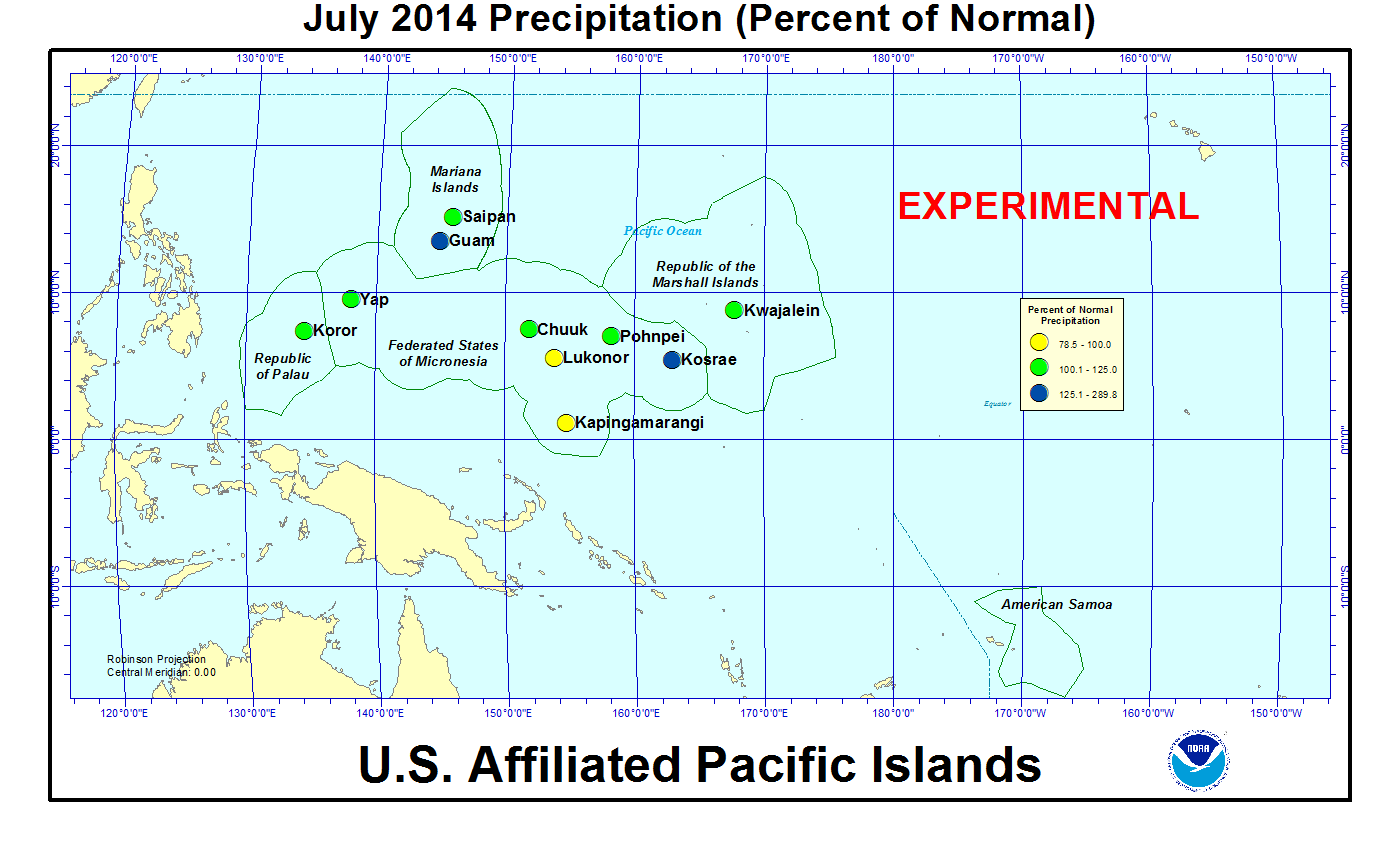


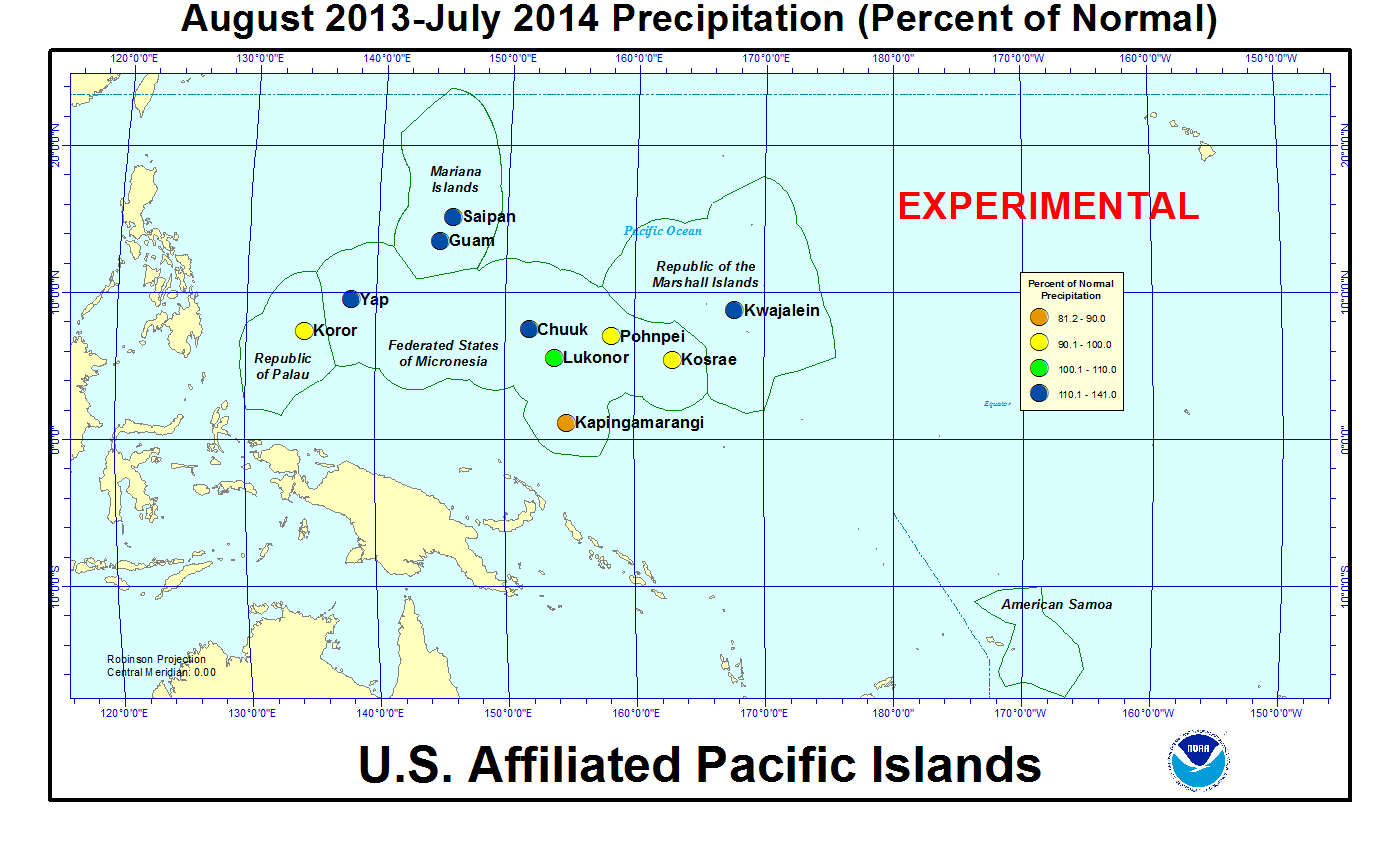
[top]
State/Regional/National Moisture Status
A detailed review of drought and moisture conditions is available for all contiguous U.S. states, the nine standard regions, and the nation (contiguous U.S.):
| northeast u. s. | east north central u. s. | central u. s. |
| southeast u. s. | west north central u. s. | south u. s. |
| southwest u. s. | northwest u. s. | west u. s. |
| Contiguous United States |
[top]
Contacts & Questions
 NOAA's National Centers for Environmental Information
NOAA's National Centers for Environmental Information
